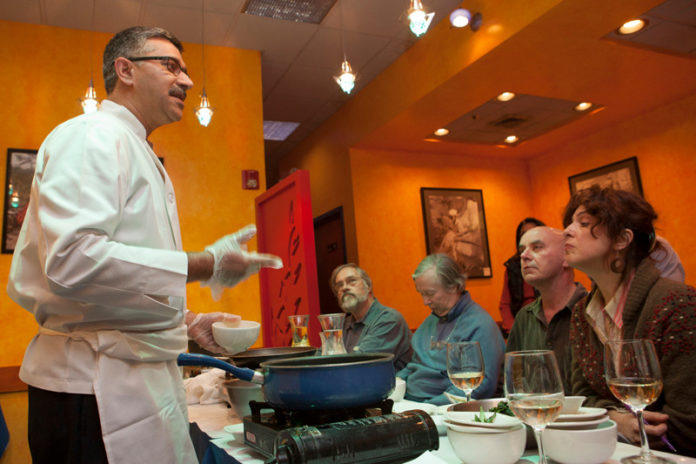
The first thing to know about Indian cooking, said Sanjiv Dhar, executive chef at and owner of Rasoi in Pawtucket, is that chefs can’t just throw together the ingredients, turn the oven up and go watch a football game.
The lamb dish he was preparing for about a dozen would-be home cooks, he said, would take 45 minutes of carefully adding the correct spices at the right time, watching to make sure they cooked properly. Of course, he told his eager students, there is always room for improvisation, and if they felt like adding something not on the ingredient list they should.
“Our recipes are not airtight,” Dhar said. “That’s not how it works. It is like a canvas and you start painting.” Dhar leads a cooking class at Rasoi, which he opened in 2006 as a sister restaurant to Kabob and Curry, the Thayer Street Indian restaurant he opened in the late 1980s, about once per month.
Dhar, who began offering the classes several years ago, has been at the forefront of a growing national trend.
The National Restaurant Association reported in a presentation it gave at the Rhode Island Hospitality Association’s Economic Outlook breakfast last fall that 33 percent of adults surveyed this year say they would attend a restaurant cooking class, up from 28 percent in the association’s 2011 restaurant industry economic forecast.
That number increases to 43 percent when pointing to adults between 18 and 34 years old.
Also, 54 percent of adults with children in their household said this year they would participate in an interactive cooking demonstration.
In its annual Restaurant Trends Survey for 2011, the association’s annual survey of industry professionals, 12 percent said cooking classes and demonstrations would be the hottest restaurant operational trend that year.
“Like other service-based businesses, the hospitality community is always looking for new ways to serve our guests,” said Dale Venturini, president and CEO of the Rhode Island Hospitality Association. “I think the real benefit is the loyalty it will foster. For a guest to be able to ‘wow’ their family and friends because of something we taught them is priceless. That is the type of service that will keep them coming back time and time again.”
The numbers bear out how difficult the business can be. According to the 2012 Restaurant Industry Forecast presented in September at the hospitality association’s outlook breakfast, Rhode Island’s restaurant industry was expected to grow 2.3 percent by year’s end. But the more recent 2013 Restaurant Industry Forecast report released by the restaurant association early in December projected that the Ocean State restaurant business will grow 7.2 percent in the next decade.
For that reason, building and maintaining customer loyalty remains challenging to owners. The National Restaurant Association’s 2013 Industry Forecast report showed that 24 percent of family dining establishments and 23 percent of fine-dining restaurants said luring repeat customers was more difficult in 2012 than the year before. The report also showed 49 percent of family restaurants and 32 percent of fine-dining restaurants felt attracting new customers was more difficult this year than last.
For some restaurant owners, at least, cooking classes help bring people back.
“The more classes we [hold], the more repeat business we get,” said Mark Maginot, owner of Gepetto’s, a pizzeria that has had its home on Providence’s Federal Hill since 2004. “It’s a great connection for people who visit us the first time. They feel part of the restaurant.”
Gepetto’s offers 90-minute classes, at $75 per person, in grilled pizza, sangria, sauces, tiramisu, dough tossing and pasta making.
The first class was held at the restaurant’s previous Thayer Street location, some 16 years ago after a customer almost dared Maginot to prove the pizza was made from actual pizza dough.
The thin crust, Maginot said, had convinced the gentleman Gepetto’s was using unleavened bread.
“[It] was more a friendly challenge, and it was really a great time, and the light bulb went on that we could do it all the time,” he said. “When you spend time with a chef or cook … it is a great connection you can’t always establish on a straight dining experience.”
While Gepetto’s classes offer a hands-on experience, the Rasoi classes are mostly demonstrations. For $40, participants get a live lecture that lasts about 1.5 hours and the opportunity to taste the dishes as they are prepared.
There are also generous wine pairings and a community meal following the demonstration.
At a recent fall class at Rasoi’s there were four pairs, plus a mother-and-son team who came to learn and eat.
Dottie Brunelli and her companion, Mark Bruck, her son’s father-in-law, were among them. The pair has eaten at Rasoi many times and both are avid home cooks who want to prepare an Indian dinner for their entire extended family.
“He cooks German, and I cook Italian, and I want to queue it up a bit. Our family is eclectic,” Brunelli said. “I think we’ve got it together now and think it will be a lot of fun.”
Dhar’s estimation of the classes’ success would mean that Brunelli and Bruck might cook something at home that they learned that night but that they still will return to Rasoi.
“I think when you cook at home, you start falling in love with a cuisine, and when you fall in love, you start enjoying it more in a restaurant. And there are certain things you can’t replicate,” Dhar said.
Ian Canning, director of continuing education at Johnson & Wales University, said the increased popularity in the idea of a celebrity chef – dating all the way back to Julia Child and growing with the Cooking Channel – has increased consumer interest in learning more about cooking.
Johnson & Wales has run its Chef Choice recreational-cooking classes for 10 years. They are at the school’s Harborside campus and vary in price. Those listed for December were $80 or $100 per person for a three-to-four hour class.
“The offerings are really geared toward things that people are interested in, like farm-to-table concepts, local sourcing, international cuisine,” Canning said. •











